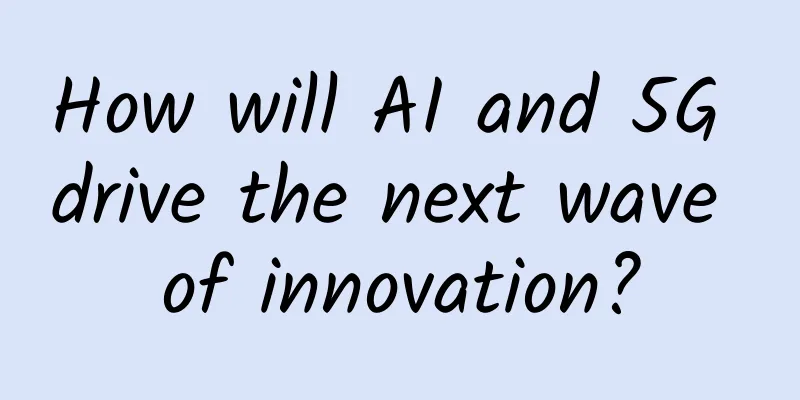How will AI and 5G drive the next wave of innovation?

|
Artificial intelligence (AI) continues to permeate every area of society and deliver new and improved experiences. It is fair to say that AI will transform every industry across the country in the next decade. 5G, not just another G, is the catalyst for this major shift. Unlike previous wireless technologies, AI-powered 5G networks were born in the cloud era and will accelerate the Fourth Industrial Revolution, creating unprecedented business opportunities. 5G networks connect data centers and smart devices based on the cost, latency, rate, and power requirements of applications. The combined power of these disruptive technologies (AI and 5G) enables cost-effective intelligent networks and Internet of Things (IoT) devices to connect quickly, securely, and ubiquitously. This convergence point is critical to concepts such as the Intelligent Wireless Edge. AI and 5G, the connected digital edgeAI and 5G are two of the most critical elements driving future innovation. These cutting-edge technologies are synergistic in nature. The rapid development of AI has significantly improved the entire 5G ecosystem, its performance, and efficiency. Moreover, the proliferation of 5G-connected devices has helped drive unparalleled intelligence and new improvements in AI-based learning and reasoning. Moreover, as on-device intelligence has gained phenomenal traction, the transformation to the connected intelligent edge has already begun. This transformation is essential to fully tap into the potential of 5G’s future. Given these prospects, these technologies have enough potential to transform every industry. Here’s how the combination of AI and 5G is reshaping industries. Conversational AI and natural language processing enable future servicesConversational AI, i.e. chatbots, voice assistants, and other messaging applications, supports multiple industries by fully automating customer service and ensuring 24/7 support. Conversational AI/chatbots have been improving over time and introducing new methods of human communication through facial expressions and contextual awareness. Helping solve complex wireless challengesAs the world continues to push the boundaries of wireless connectivity, new issues may emerge as challenges to solve. Artificial intelligence and 5G offer potential solutions to these challenges with new levels of performance and efficiency. In addition, on-device AI benefits the entire 5G system through radio sensing, which can support enhanced system performance, including improved spectrum utilization and reduced interference. 5G ensures better radio security, protection against malicious attacks, and improved detection. It also ensures enhanced device experiences such as power management and intelligent beamforming. Facilitating urban planning and traffic managementVisual inspection software driven by artificial intelligence monitors every moving and non-moving element to safeguard every aspect of city operations. This includes ensuring safety, traffic, drainage and space management throughout the city through interconnected devices and servers. This level of progress is only possible with the help of 5G technology. 5G technology enables cities to operate intelligently in a busy environment where thousands of people and things interact with each other. 5G also helps generate massive amounts of data to support decision makers in upgrading urban management. Allowing edge computing to extend realityCables don’t limit augmented reality (AR) and virtual reality (VR). But advanced wireless technologies like 5G can enable real-time design changes in augmented reality and allow for virtual presence anywhere through virtual reality. Vehicle defect detectionAutomakers can identify and analyze vehicle defects and thoroughly check for quality issues on assembly lines. Visual inspection software, such as cameras, monitor automated vehicle assembly and allow the automotive industry to do this successfully with the support of deep learning algorithms. Increase speed and integration with other technologies5G, as an advanced technology, significantly improves the speed and accuracy of other technologies. At the same time, artificial intelligence enables machines and systems to operate as intelligently as humans. For easy understanding, 5G accelerates cloud services, while AI quickly analyzes and learns from the same data. SummarizeAI and 5G are leading the way in the following revolutionary technologies. As mentioned above, when industries combine and leverage AI and 5GI, they can unleash unparalleled productivity and efficiency. While the unified power of these technologies has not yet fully arrived, the vast prospects of 5G deployment on a large scale are not far away. |
<<: What is the difference between unmanaged and managed industrial network switches?
Recommend
Tencent held the second Service Innovation Conference to implement the concept of "Service-oriented, Technology for Good"
On December 7, the second SICC Service Innovation...
In the era of cloud computing, what issues should data center operation and maintenance pay attention to?
In the era of cloud computing, IT system construc...
Wireless sensor network standardization progress and protocol analysis
[[188829]] As an application-oriented research fi...
Where does the strength of 5G factories that “take over” 5G+Industrial Internet come from?
In order to accelerate the industry's quality...
5G network speed has shrunk? Q3 saw a year-on-year decline of up to 39%
Recently, Ookla, a network connection speed testi...
Adhere to innovation and sink into the scene Ruijie takes action to keep up with the education informatization 2.0
The three-day 74th China Educational Equipment Ex...
As technology giants rush to enter the market, what kind of development will the satellite communications field usher in?
In recent years, the global satellite communicat...
Work together to build a secure network and digital ecosystem
Today, digital transformation led by emerging tec...
RackNerd June Promotion: 1.5G memory VPS annual payment starts at $15.78, multiple data centers in San Jose/Seattle, etc.
RackNerd released a promotional package for June,...
How to Choose Inventory Tracking Technology?
What is inventory tracking technology? Inventory ...
How do base stations go to the sky?
[[348593]] This article is reprinted from the WeC...
Hosteons: $8.99/month Hybrid Servers-dual core, 8GB memory, 100GB NVMe, 30TB/10Gbps, Salt Lake City data center
Hosteons has recently started to experiment with ...
HostYun Los Angeles CN2 GIA line AMD series VPS simple test
We have shared information about VPS hosts in var...
Can this be considered? TCP is awesome.
Hello everyone, I am Xiaolin. I saw an old man as...
IPv6 Multicast Technology and Dual Protocol Stack Technology
1. IPv6 Multicast Technology IP multicast is an e...









